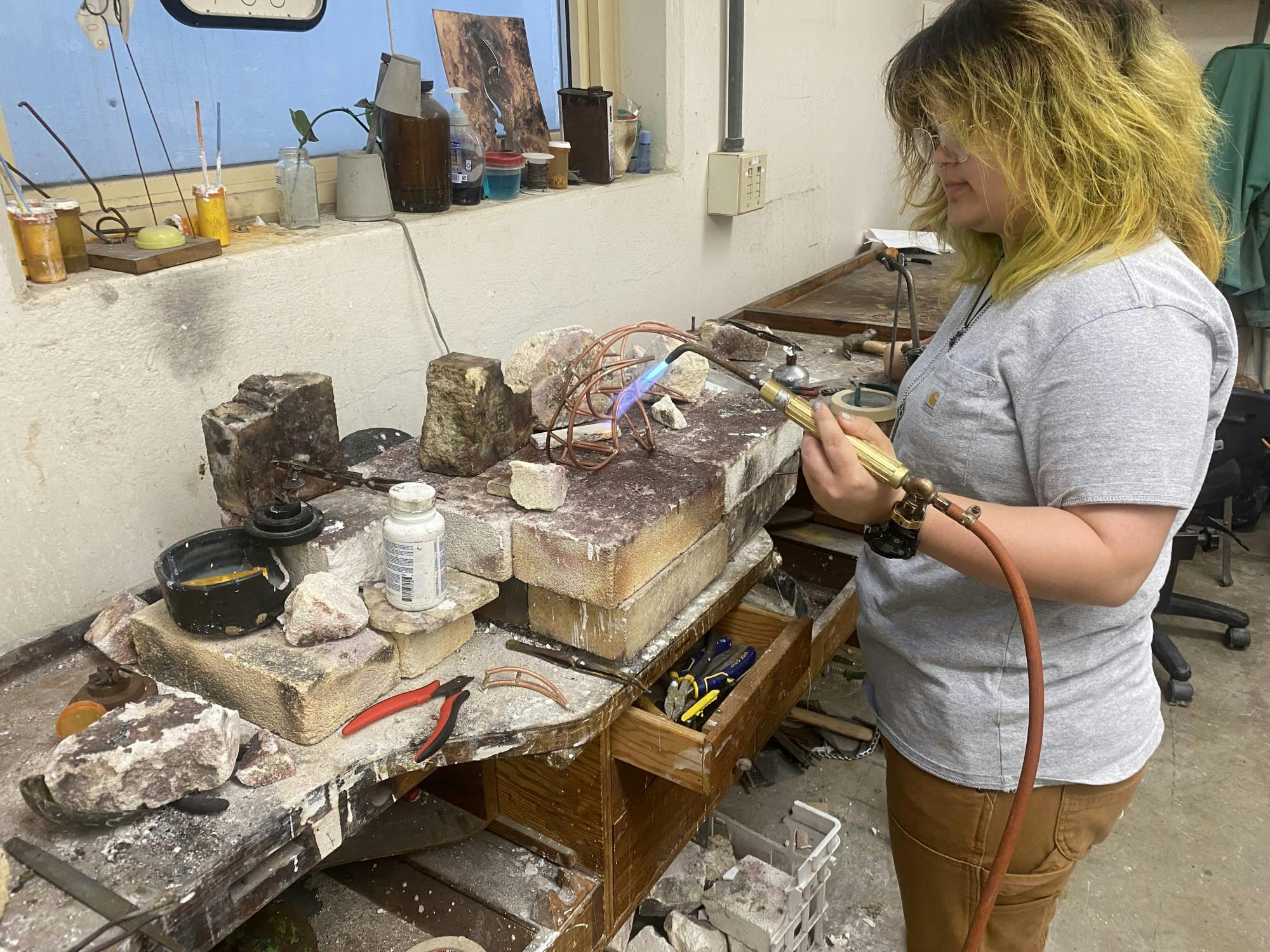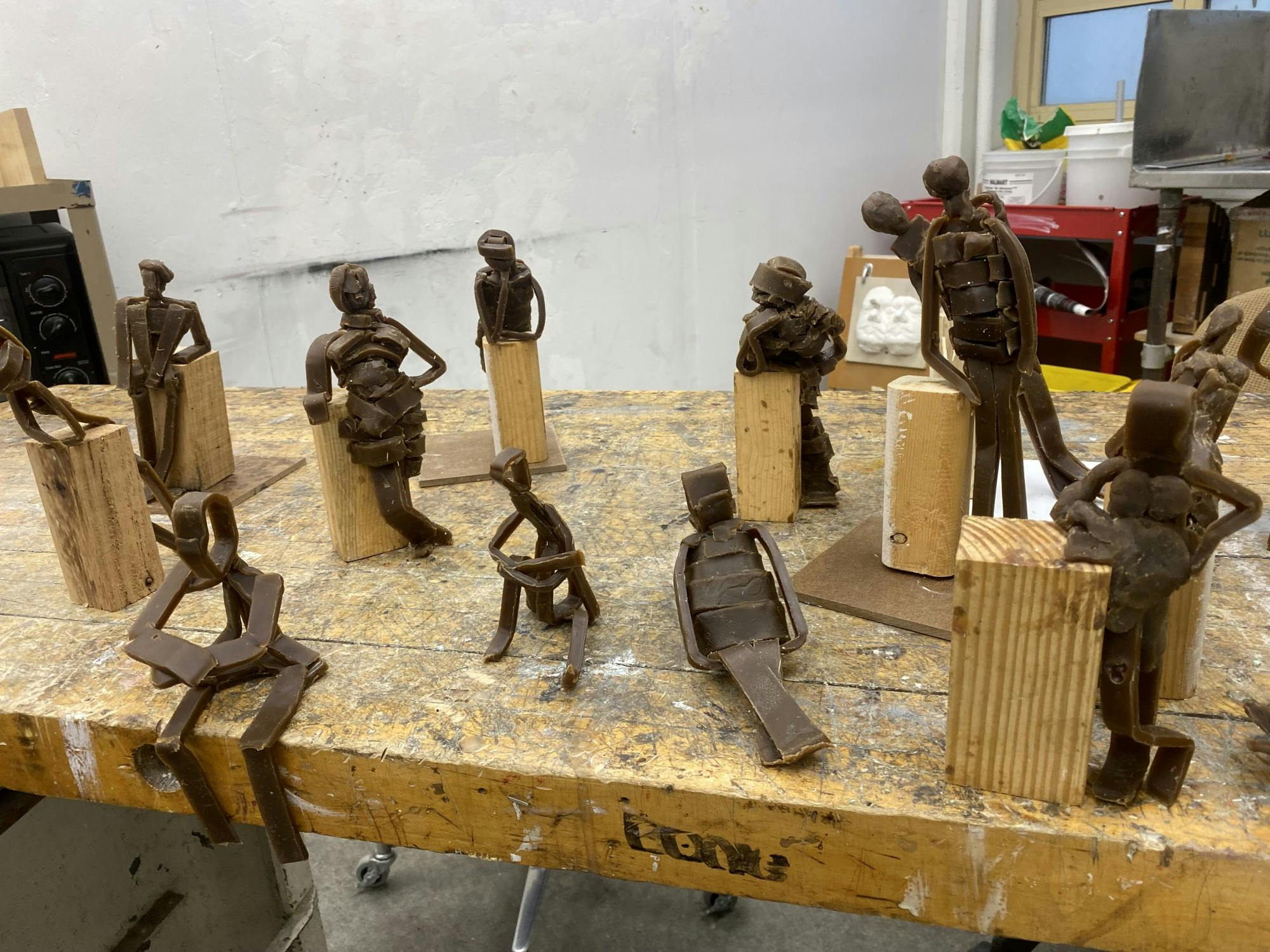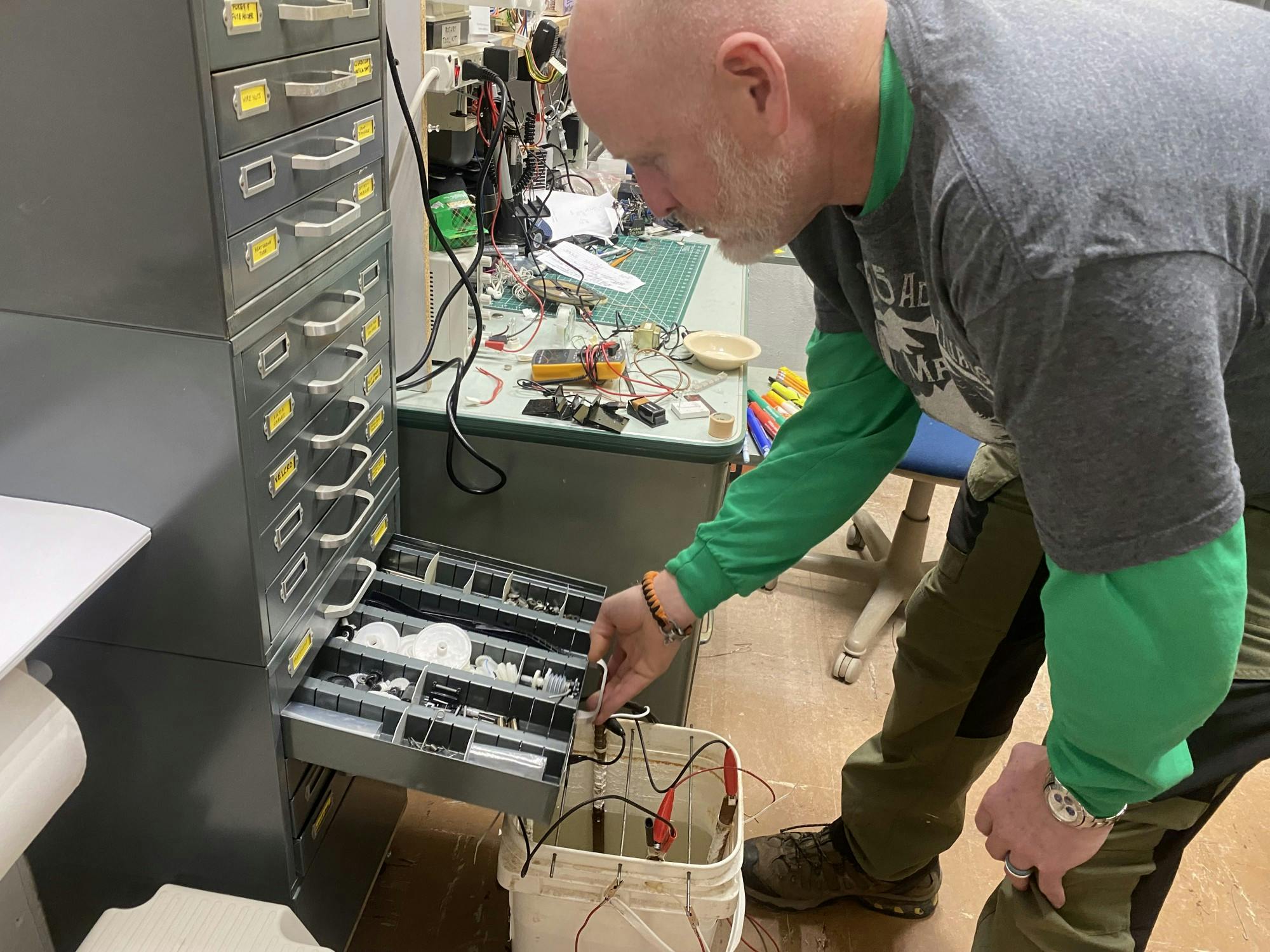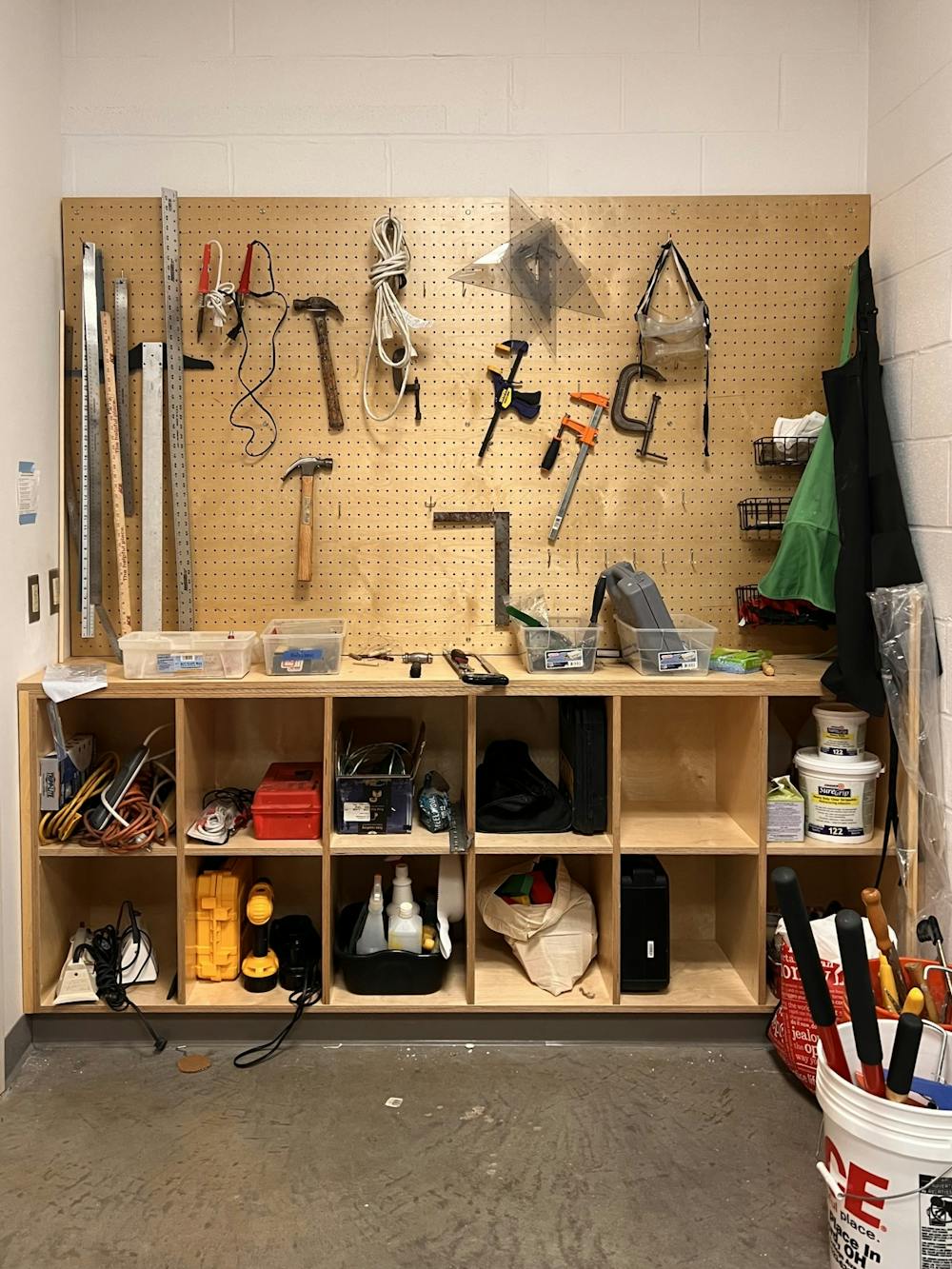Kayla Lynskey, a senior studio art major at Miami University, appreciates her roommates, who bring in her Amazon packages that arrive almost daily with art supplies needed for her classes.
What she isn’t thankful for, however, is the blow that all the materials take to her bank account.
“I have a job here, so that helps me at least bring some more money in while I’m spending on materials,” Lynskey said. “I also have some money that’s saved away for expenses for my projects and for school in general. But it still kind of makes me be like, ‘Oh my gosh, I’m gonna freak out that I’m spending this much money on stuff.’”
Lynskey, like all other art majors, is handed a supply list for each of her studio classes at the beginning of the semester, almost all of which are to be paid for out of their own pockets on top of various studio fees.

Studio art major Kayla Lynskey uses a torch to soften the metal so she can bend and work with it in her art.
“For me personally, I’m able to get some help from my parents for materials, which I’m really thankful for,” Lynskey said. “But I also know some other students who aren’t able to do that. And they’re constantly trying to put the money together for the materials.”
Lacey Clark, a junior art education major, said she had to buy materials for many of her foundation courses, as well as each of the six studio art classes she is required to take. For the studio courses, she spends anywhere from $100 to $300 per class.
“It’s kind of outrageous,” Clark said. “I’d probably say you could easily spend $500 in a semester. And that’s just the base — you have to spend more if you screw up or ruin anything.”
Most studio art classes also include studio fees, which cover equipment that can be shared by all students, like rollers for printmaking and tools for jewelry making. Clark said paying for all her supplies in addition to the fees has been a financial burden.
“I’m a commuter. I have my bills at home,” Clark said. “Last semester I opened up a credit card in order to offset my materials because I didn’t have the money at the time.”
However, Clark said most of her professors are understanding of the pressure these costs can put on students. One of her professors, whom she buys supplies directly from, allows her to wait to repay her until she has adequate funds.
Enjoy what you're reading?
Signup for our newsletter
“It’s kind of touching,” Clark said. “It depends on who the professor is, but they’re all aware that it is an issue and some are better with giving more heads up so you’re able to save up and get it at a place that’s easier. Some will kind of be like, ‘Oh, you need all of this for this project. You have two weeks to get it,’ and it’s kind of overwhelming at times.”
Tracy Featherstone, professor of art and printmaking, tries to keep the costs for her printmaking course as low as possible. A $30 lab fee goes toward shared supplies like ink, and students are asked to bring in the remaining materials.
“Most of the stuff [students] have to buy are things like paper and tape and other kinds of personal supplies that are expendable,” Featherstone said. “We can’t all share paper because they’re gonna be printing their stuff on it. And I ask them to bring a box of general supplies like pencils and erasers and things like that.”
Featherstone said she’s aware of the burden these costs put on some students.
“The printmaking paper is usually about $5 a sheet and you might be able to get four prints out of it, but they’re making hundreds of prints a semester,” Featherstone said. “I know it’s hard. I can see the students, a lot of times they’ll make really small prints because they can get more out of the sheet of paper they’re using.”
For students who are struggling with paying for the supplies, Featherstone said she can recommend them for a scholarship within the art department to cover some of these costs.
“[Students have] come up to me right after I gave the supply list, and they’re like, ‘I really wanted to be in this class but I don’t think I can afford the supplies,’” Featherstone said. “So if something like that happens, I can refer them to the chair and write a little letter of recommendation.”
Amanda Alexander, art department chair, said the money comes from the Tara Savage Fund, which provides up to $250 to students for their materials. Students are nominated by a faculty member before submitting a piece of writing demonstrating their need. Then, their application is sent to Alexander to be approved or disapproved.
Although Alexander only started her position in July, she said she received around five nominations last semester, and one or two this semester.
“Those that have needed it so far, I have approved it, but it’s a certain amount of funding and once it’s gone, it's gone,” Alexander said. “So we have to be careful with making sure it’s being used justifiably for somebody who’s in need.”
While paying for supplies may be difficult for students, acquiring the materials is an additional challenge for those who don’t have a car in Oxford. While smaller supplies can be delivered, larger ones can be harder to obtain.
Rod Northcutt, professor of sculpture, said he offers to pick up supplies like large pieces of wood for his students at stores like ACE hardware.
“If you don’t want to be that student that’s got the six-foot longboard with a story on the bus, you can just go there, buy it, say ‘Rod’s gonna pick it up’ and just email or text me,” Northcutt said. “And then I stop by ACE in the morning and take it up in the truck and bring it in. No problem.”
Northcutt’s Sculpture 1 class includes a $100 studio fee. Although students may choose to go out and buy supplies for their projects, he tries to offer enough in-studio materials for everyone.
“I get some students that are really close to the vest with their finances, and some are parents, some are putting themselves through school. They might be regional students that are coming and taking sculpture here,” Northcutt said. “So I try to make sure I don’t have a prohibitive price tag on anything.”

Dr. Northcutt's Sculpture 1 students create human-like figures using wax for one of their assignments. The materials are covered by the students' lab fee.
Although Northcutt encourages students to repurpose anything they can find — old TVs, half-used supplies handed down from former students, discarded furniture — sometimes he has to provide the materials himself.
“It’s inevitable,” Northcutt said. “A lot of times we can’t afford to get a particular tool for the studio, but I happen to have one so I bring it in. We just can’t afford every professional electronics tool, every wielding or blacksmithing tool. So I do bring in my own stuff. It gets damaged sometimes, that’s just part of [the process]. And I do end up spending some of my own money on the courses as well.”

Rod Northcutt, professor of sculpture at Miami, stores various electrical supplies like old adapters for students to use in their projects.
Lynskey said she knows it’s unrealistic to think the department could pay for all of every student’s supplies, but a material exchange could be beneficial. For some classes, like Painting 1 (with a supply cost nearing $300), many students have supplies left over that they may not use if they don’t continue to Painting 2.
Lynskey also acknowledged that having to pay for her supplies now is preparing her for how it will be in the real world.
“It’s kind of eye-opening because once we get out of here and graduate, then we’re going to have to pay for our own supplies,” Lynskey said. “So it kind of helps put into perspective how much we have to pay and save.”
Alexander added that, although the situation isn’t ideal for students or faculty, there doesn’t seem to be any alternative model.
“Across the country, if you were to survey similar art departments at universities, you’re going to find a very similar model as ours,” Alexander said. “That’s just the way it’s always been. I don’t know if that’s a very good justification for why we do it now, but our budgets are so that we can’t afford to buy all the supplies for all the students anyway.”
Alexander said the department tries to make the most of the funds allocated to it by the university.
“[Our budgets are] not large, I can say that. It’s enough to get us by, enough to be able to do what we need to do,” Alexander said. “We try to do our best in terms of supporting students and we want students to succeed. But we also only have so much to give. So it’s kind of a balance.”




